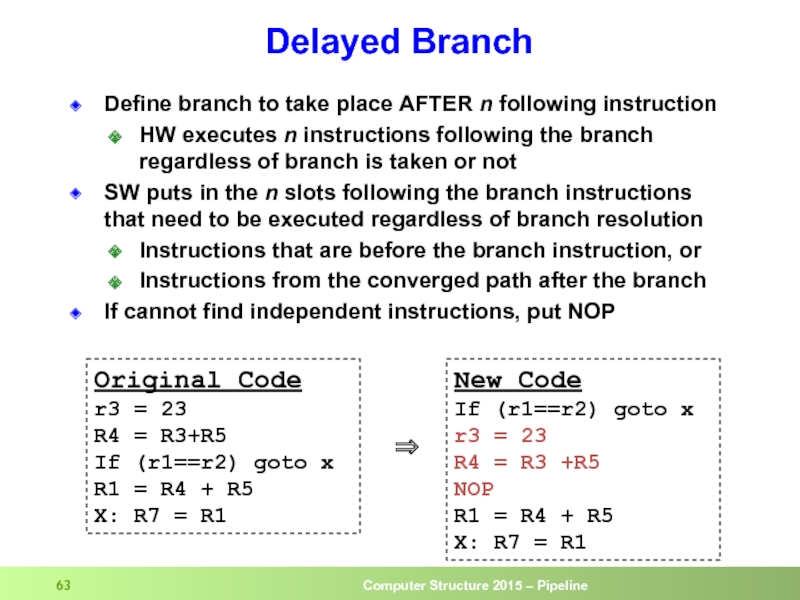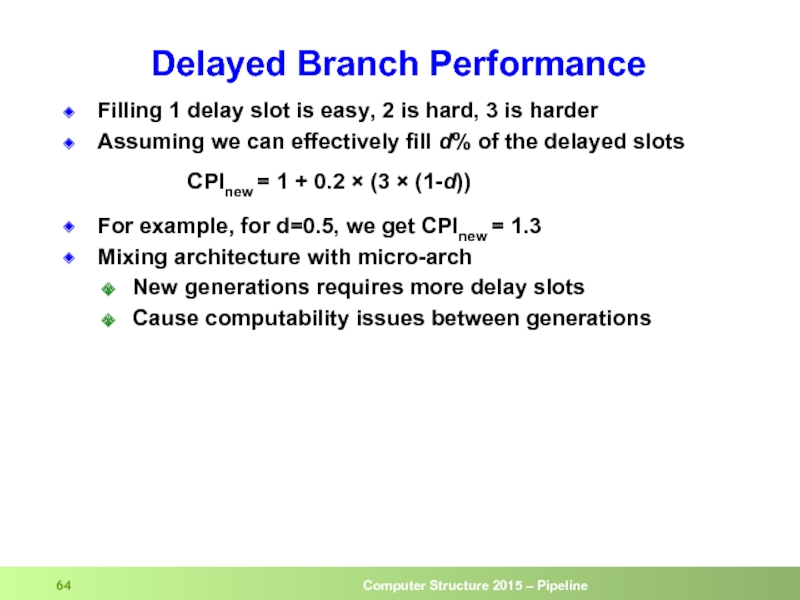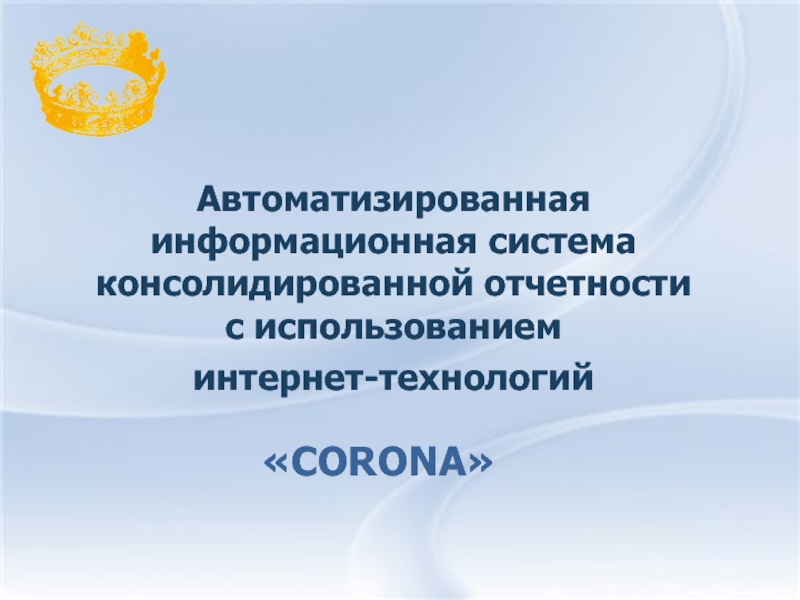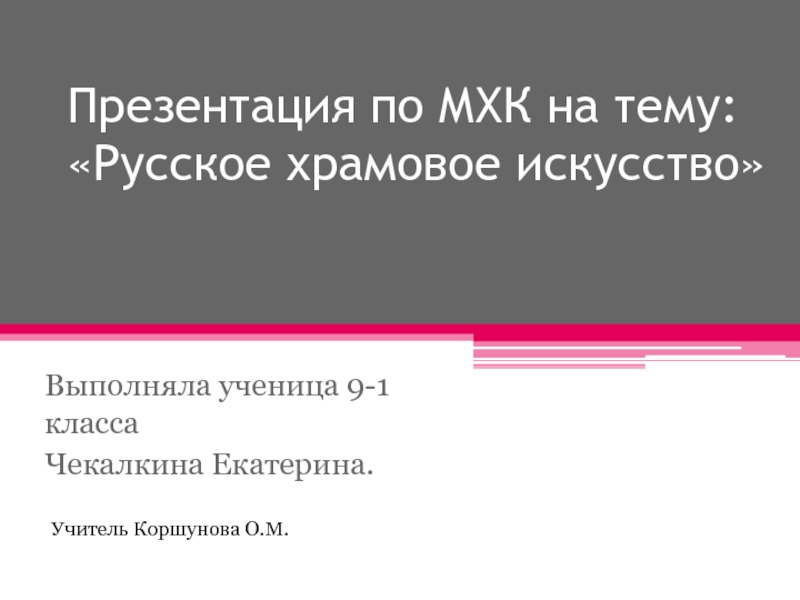- Главная
- Разное
- Дизайн
- Бизнес и предпринимательство
- Аналитика
- Образование
- Развлечения
- Красота и здоровье
- Финансы
- Государство
- Путешествия
- Спорт
- Недвижимость
- Армия
- Графика
- Культурология
- Еда и кулинария
- Лингвистика
- Английский язык
- Астрономия
- Алгебра
- Биология
- География
- Детские презентации
- Информатика
- История
- Литература
- Маркетинг
- Математика
- Медицина
- Менеджмент
- Музыка
- МХК
- Немецкий язык
- ОБЖ
- Обществознание
- Окружающий мир
- Педагогика
- Русский язык
- Технология
- Физика
- Философия
- Химия
- Шаблоны, картинки для презентаций
- Экология
- Экономика
- Юриспруденция
Computer structure pipeline презентация
Содержание
- 1. Computer structure pipeline
- 2. A Basic Processor Memory Write
- 3. Pipelined Car Assembly chassis engine finish 1
- 5. Pipelining Pipelining does not reduce the latency
- 6. Pipelined CPU dst
- 7. Structural Hazard Different instructions using the same
- 8. Pipeline Example: cycle 1 0 lw
- 9. Pipeline Example: cycle 2 0 lw
- 10. Pipeline Example: cycle 3 0 lw
- 11. Pipeline Example: cycle 4 0 lw
- 12. Pipeline Example: cycle 5 0 lw
- 13. RAW Dependency sub
- 14. Using Bypass to Solve RAW Dependency
- 15. RAW Dependency 0 lw R4,9(R1)
- 16. Forwarding Hardware 0 lw R4,9(R1)
- 17. Forwarding Control Forwarding from EXE (L3)
- 18. Register File Split Register file is written
- 19. Load word can still causes a
- 20. De-assert the enable to the L1 latch,
- 21. Example: code for (assume all variables are
- 22. Control Hazards
- 23. Control Hazard on Branches
- 24. Control Hazard on Branches
- 25. Control Hazard on Branches
- 26. Control Hazard on Branches
- 27. Control Hazard on Branches
- 28. Control Hazard on Branches And Beq sub
- 29. Control Hazard: Stall Stall pipe when branch
- 30. Control Hazard: Predict Not Taken Execute instructions
- 31. Dynamic Branch Prediction Add a Branch Target
- 32. BTB Allocation Allocate instructions identified as branches
- 33. BTB (cont.) Wrong prediction Predict not-taken, actual
- 34. Adding a BTB to the Pipeline 4
- 35. Adding a BTB to the Pipeline 50
- 36. Adding a BTB to the Pipeline or
- 37. Using The BTB PC moves to next
- 38. Using The BTB (cont.) ID EXE MEM
- 39. Backup
- 40. R-type (register insts)
- 41. Each memory location is 8 bit
- 42. Register File The Register File holds 32
- 43. Memory Components Inputs Address: address of the
- 44. The Program Counter (PC) Holds the address
- 45. Fetch Fetch instruction pointed by PC from
- 46. The MIPS CPU Instruction Decode /
- 47. Executing an Add Instruction R3 R5 3
- 48. Executing a Load Instruction LW R1, (30)R2 ; R1 ← Mem[R2+30]
- 49. Executing a Store Instruction SW R1, (30)R2 ; Mem[R2+30] ← R1
- 50. Executing a BEQ Instruction BEQ R4, R5,
- 51. Control Signals
- 52. Pipelined CPU: Load (cycle 1 – Fetch)
- 53. Pipelined CPU: Load (cycle 2 – Dec)
- 54. Pipelined CPU: Load (cycle 3 – Exe)
- 55. Pipelined CPU: Load (cycle 4 – Mem)
- 56. Pipelined CPU: Load (cycle 5 – WB)
- 57. Datapath with Control
- 58. Multi-Cycle Control Pass control signals along just like the data
- 59. Five Execution Steps Instruction Fetch Use PC
- 60. Five Execution Steps (cont.) Execution
- 61. The Store Instruction sw rt, rs, imm16 mem[PC] Fetch the instruction from memory Addr
- 62. RAW Hazard: SW Solution
- 63. Delayed Branch Define branch to take place
- 64. Delayed Branch Performance Filling 1 delay slot
Слайд 2A Basic Processor
Memory
Write
back
Execute
Decode
Fetch
PC
Data
Cache
Register
File
Control signals
ALU
Inst.
src1
Inst.
Cache
address
Sign
Ext.
Mem
Rd/Wr
ALU control
decode
src1
data
src2
data
src2
dst
data
dst reg
ALU source
imm
src2
src1
Write-back value
imm
opcode
src1 reg
src2
Слайд 4
Data
Access
Data
Access
Data
Access
Data
Access
Data
Access
Pipelining Instructions
Ideal speedup is number of stages in the pipeline. Do
2
4
6
8
1
0
1
2
1
4
1
6
1
8
2
4
6
8
1
0
1
2
1
4
.
.
.
Inst
Fetch
Reg
ALU
Reg
Inst
Fetch
Reg
ALU
Reg
Inst
Fetch
Inst
Fetch
Reg
ALU
Reg
Inst
Fetch
Reg
ALU
Reg
Inst
Fetch
Reg
ALU
Reg
2 ns
2 ns
2 ns
2 ns
2 ns
2 ns
2 ns
8 ns
8 ns
8 ns
Слайд 5Pipelining
Pipelining does not reduce the latency of single task,
it increases
Potential speedup = Number of pipe stages
Pipeline rate is limited by the slowest pipeline stage
Partition the pipe to many pipe stages
Make the longest pipe stage to be as short as possible
Balance the work in the pipe stages
Pipeline adds overhead (e.g., latches)
Time to “fill” pipeline and time to “drain” it reduces speedup
Stall for dependencies
Too many pipe-stages start to loose performance
IPC of an ideal pipelined machine is 1
Every clock one instruction finishes
Слайд 7Structural Hazard
Different instructions using the same resource at the same time
Register
Accessed in 2 stages:
Read during stage 2 (ID)
Write during stage 5 (WB)
Solution: 2 read ports, 1 write port
Memory
Accessed in 2 stages:
Instruction Fetch during stage 1 (IF)
Data read/write during stage 4 (MEM)
Solution: separate instruction cache and data cache
Each functional unit can only be used once per instruction
Each functional unit must be used at the same stage for all instructions
Слайд 13
RAW Dependency
sub R2, R1, R3
and R12,R2, R5
or R13,R6, R2
add R14,R2, R2
sw
Program
execution
order
Слайд 14Using Bypass to Solve RAW Dependency
sub R2, R1, R3
and R12,R2, R5
or
add R14,R2, R2
sw R15,100(R2)
Program
execution
order
Bypass result directly from EXE output to EXE input
Слайд 17Forwarding Control
Forwarding from EXE (L3)
if (L3.RegWrite and (L3.dst == L2.src1))
if (L3.RegWrite and (L3.dst == L2.src2)) ALUSelB = 1
Forwarding from MEM (L4)
if (L4.RegWrite and
((not L3.RegWrite) or (L3.dst ≠ L2.src1)) and
(L4.dst = L2.src1)) ALUSelA = 2
if (L4.RegWrite and
((not L3.RegWrite) or (L3.dst ≠ L2.src2)) and
(L4.dst = L2.src2)) ALUSelB = 2
Слайд 18Register File Split
Register file is written during first half of the
Register file is read during second half of the cycle
Register file is written before it is read ⇒ returns the correct data
Слайд 19
Load word can still causes a hazard:
an instruction tries to read
A hazard detection unit is needed to “stall” the load instruction
Can't Always Forward
Слайд 20De-assert the enable to the L1 latch, and to the IP
The
Issue a NOP into the L2 latch (instead of the stalled inst.)
Allow the stalling instruction (lw) to move on
Stall If Cannot Forward
if (L2.RegWrite and (L2.opcode == lw) and
( (L2.dst == L1.src1) or (L2.dst == L1.src2) ) then stall
Слайд 21Example: code for (assume all variables are in memory):
a = b
d = e – f;
Slow code
LW Rb,b
LW Rc,c
Stall ADD Ra,Rb,Rc
SW a,Ra
LW Re,e
LW Rf,f
Stall SUB Rd,Re,Rf
SW d,Rd
Instruction order can be changed as long as the correctness is kept
Software Scheduling to Avoid Load Hazards
Fast code
LW Rb,b
LW Rc,c
LW Re,e
ADD Ra,Rb,Rc
LW Rf,f
SW a,Ra
SUB Rd,Re,Rf
SW d,Rd
Слайд 28Control Hazard on Branches
And
Beq
sub
mul
The 3 instructions
following the branch
get into
if the branch is taken
Inst from target
Слайд 29Control Hazard: Stall
Stall pipe when branch is encountered until resolved
Stall impact:
CPI = 1
20% of instructions are branches
Stall 3 cycles on every branch
⇒ CPI new = 1 + 0.2 × 3 = 1.6
(CPI new = CPI Ideal + avg. stall cycles / instr.)
We loose 60% of the performance
Слайд 30Control Hazard: Predict Not Taken
Execute instructions from the fall-through (not-taken) path
As
If the branch is not-taken (~50%), no penalty is paid
If branch actually taken
Flush the fall-through path instructions before they change the machine state (memory / registers)
Fetch the instructions from the correct (taken) path
Assuming ~50% branches not taken on average
CPI new = 1 + (0.2 × 0.5) × 3 = 1.3
Слайд 31Dynamic Branch Prediction
Add a Branch Target Buffer (BTB) that predicts (at
Instruction is a branch
Branch taken / not-taken
Taken branch target
BTB allocated at execute – after all branch info is known
BTB is looked up at instruction fetch
Слайд 32BTB
Allocation
Allocate instructions identified as branches (after decode)
Both conditional and unconditional branches
Not taken branches need not be allocated
BTB miss implicitly predicts not-taken
Prediction
BTB lookup is done parallel to IC lookup
BTB provides
Indication that the instruction is a branch (BTB hits)
Branch predicted target
Branch predicted direction
Branch predicted type (e.g., conditional, unconditional)
Update (when branch outcome is known)
Branch target
Branch history (taken / not-taken)
Слайд 33BTB (cont.)
Wrong prediction
Predict not-taken, actual taken
Predict taken, actual not-taken, or actual
In case of wrong prediction – flush the pipeline
Reset latches (same as making all instructions to be NOPs)
Select the PC source to be from the correct path
Need get the fall-through with the branch
Start fetching instruction from correct path
Assuming P% correct prediction rate
CPI new = 1 + (0.2 × (1-P)) × 3
For example, if P=0.7
CPI new = 1 + (0.2 × 0.3) × 3 = 1.18
Слайд 34Adding a BTB to the Pipeline
4
50
50
Lookup current IP in IC and
IC provides the instruction bytes
jcc
BTB provides predicted target and direction
0 or
4 jcc 50
8 and
...
50 sub
54 mul
58 add
or
taken
taken
8
Слайд 35Adding a BTB to the Pipeline
50
taken
8
jcc
sub
50
54
0 or
4 jcc 50
50 sub
54 mul
58 add
or
42
Слайд 36Adding a BTB to the Pipeline
or
jcc
50
taken
0 or
4 jcc 50
50 sub
54 mul
58 add
54
58
sub
mul
8
50
taken
Verify direction
Verify target (if taken)
Issue flush in case of mismatch
Along with the repair IP
Слайд 37Using The BTB
PC moves to next instruction
Inst Mem gets PC
and fetches
BTB gets PC
and looks it up
IF/ID latch loaded
with new inst
PC ← PC + 4
PC ← perd addr
IF
ID
IF/ID latch loaded
with pred inst
IF/ID latch loaded
with seq. inst
yes
no
no
yes
no
yes
EXE
Слайд 38Using The BTB (cont.)
ID
EXE
MEM
WB
Calculate br
cond & trgt
Flush pipe &
update PC
yes
no
IF/ID latch
with correct inst
continue
Update BTB
yes
no
continue
Слайд 40R-type
(register insts)
I-type (Load,
Store, Branch,
inst’s
data)
J-type (Jump)
op: operation of the instruction
rs, rt, rd: the source and destination register specifiers
shamt: shift amount
funct: selects the variant of the operation in the “op” field
address / immediate: address offset or immediate value
target address: target address of the jump instruction
MIPS Instruction Formats
Слайд 41Each memory location
is 8 bit = 1 byte wide
has an
We assume 32 byte address
An address space of 232 bytes
Memory stores both instructions and data
Each instruction is 32 bit wide ⇒ stored in 4 consecutive bytes in memory
Various data types have different width
The Memory Space
Слайд 42Register File
The Register File holds 32 registers
Each register is 32 bit
The RF supports parallel
reading any two registers and
writing any register
Inputs
Read reg 1/2: #register whose value will be output on Read data 1/2
RegWrite: write enable
Write reg (relevant when RegWrite=1)
#register to which the value in Write data is written to
Write data (relevant when RegWrite=1)
data written to Write reg
Outputs
Read data 1/2: data read from Read reg 1/2
Слайд 43Memory Components
Inputs
Address: address of the memory location we wish to access
Read:
Write: write data into location
Write data (relevant when Write=1) data to be written into specified location
Outputs
Read data (relevant when Read=1) data read from specified location
Cache
Memory components are slow relative to the CPU
A cache is a fast memory which contains only small part of the memory
Instruction cache stores parts of the memory space which hold code
Data Cache stores parts of the memory space which hold data
Слайд 44The Program Counter (PC)
Holds the address (in memory) of the next
After each instruction, advanced to point to the next instruction
If the current instruction is not a taken branch,
the next instruction resides right after the current instruction
PC ← PC + 4
If the current instruction is a taken branch,
the next instruction resides at the branch target
PC ← target (absolute jump)
PC ← PC + 4 + offset×4 (relative jump)
Слайд 45Fetch
Fetch instruction pointed by PC from I-Cache
Decode
Decode instruction (generate control signals)
Fetch
Execute
For a memory access: calculate effective address
For an ALU operation: execute operation in ALU
For a branch: calculate condition and target
Memory Access
For load: read data from memory
For store: write data into memory
Write Back
Write result back to register file
update program counter
Instruction Execution Stages
Instruction
Fetch
Instruction
Decode
Execute
Memory
Result
Store
Слайд 46The MIPS CPU
Instruction
Decode /
register fetch
Instruction
fetch
Execute /
address
calculation
Memory
access
Write
back
Слайд 50Executing a BEQ Instruction
BEQ R4, R5, 27 ; if (R4-R5=0)
else PC ← PC+4
op
rs
rt
immediate
0
16
21
26
31
4
5
27
BEQ
Слайд 52Pipelined CPU: Load (cycle 1 – Fetch)
lw
op
rs
rt
immediate
0
16
21
26
31
2
1
30
LW
LW R1, (30)R2 ;
PC+4
Слайд 53Pipelined CPU: Load (cycle 2 – Dec)
op
rs
rt
immediate
0
16
21
26
31
2
1
30
LW
LW R1, (30)R2 ;
PC+4
R2
30
Слайд 54Pipelined CPU: Load (cycle 3 – Exe)
op
rs
rt
immediate
0
16
21
26
31
2
1
30
LW
LW R1, (30)R2 ;
R2+30
Слайд 55Pipelined CPU: Load (cycle 4 – Mem)
op
rs
rt
immediate
0
16
21
26
31
2
1
30
LW
LW R1, (30)R2 ;
D
Слайд 56Pipelined CPU: Load (cycle 5 – WB)
op
rs
rt
immediate
0
16
21
26
31
2
1
30
LW
LW R1, (30)R2 ;
D
Слайд 59Five Execution Steps
Instruction Fetch
Use PC to get instruction and put it
Increment the PC by 4 and put the result back in the PC.
IR = Memory[PC]; PC = PC + 4;
Instruction Decode and Register Fetch
Read registers rs and rt
Compute the branch address
A = Reg[IR[25-21]]; B = Reg[IR[20-16]]; ALUOut = PC + (sign-extend(IR[15-0]) << 2);
We aren't setting any control lines based on the instruction type (we are busy "decoding" it in our control logic)
Слайд 60Five Execution Steps (cont.)
Execution
ALU is performing one of three
Memory Reference: effective address calculation. ALUOut = A + sign-extend(IR[15-0]);
R-type: ALUOut = A op B;
Branch: if (A==B) PC = ALUOut;
Memory Access or R-type instruction completion
Write-back step
Слайд 61The Store Instruction
sw rt, rs, imm16
mem[PC] Fetch the instruction from memory
Addr
Calculate the memory address
Mem[Addr] <- R[rt] Store the register into memory
PC <- PC + 4 Calculate the next instruction’s address
Mem[Rs + SignExt[imm16]] <- Rt Example: sw rt, rs, imm16
Слайд 62RAW Hazard: SW Solution
I
M
R
e
g
C
C
1
C
C
2
C
C
3
C
C
4
C
C
5
C
C
6
Time (clock
C
C
7
C
C
8
C
C
9
10
1
0
/
–
2
0
Value of R2
D
M
R
e
g
sub R2, R1, R3
NOP
NOP
NOP
and R12,R2, R5
or R13,R6, R2
add R14,R2, R2
sw R15,100(R2)
Program
execution
order
10
10
10
-20
-20
-20
-20
Have compiler avoid hazards by adding NOP instructions
Problem: this really slows us down!
Слайд 63Delayed Branch
Define branch to take place AFTER n following instruction
HW executes
SW puts in the n slots following the branch instructions that need to be executed regardless of branch resolution
Instructions that are before the branch instruction, or
Instructions from the converged path after the branch
If cannot find independent instructions, put NOP
Original Code
r3 = 23
R4 = R3+R5
If (r1==r2) goto x
R1 = R4 + R5
X: R7 = R1
New Code
If (r1==r2) goto x r3 = 23
R4 = R3 +R5
NOP
R1 = R4 + R5
X: R7 = R1
⇒
Слайд 64Delayed Branch Performance
Filling 1 delay slot is easy, 2 is hard,
Assuming we can effectively fill d% of the delayed slots
CPInew = 1 + 0.2 × (3 × (1-d))
For example, for d=0.5, we get CPInew = 1.3
Mixing architecture with micro-arch
New generations requires more delay slots
Cause computability issues between generations
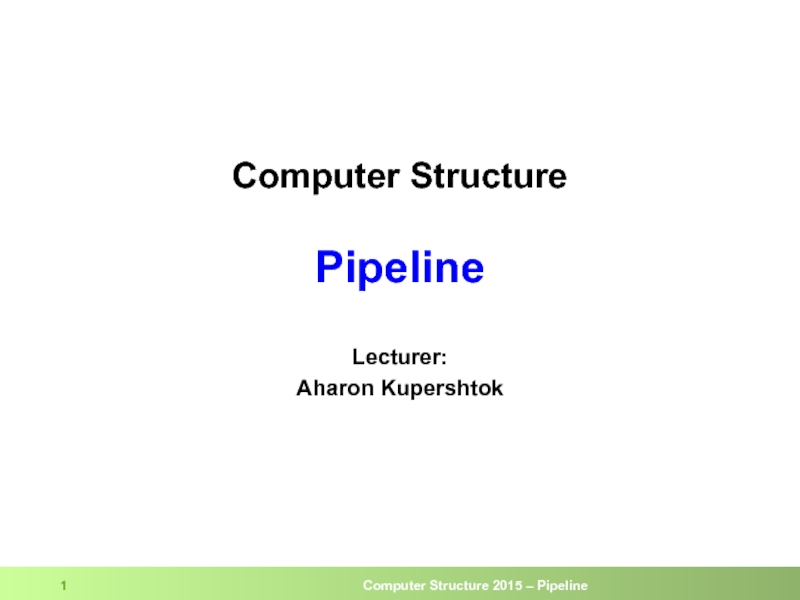
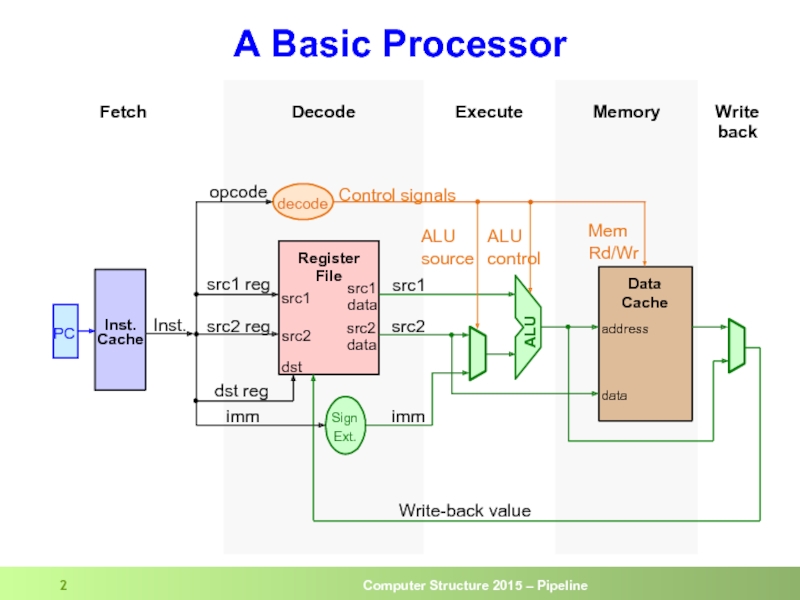
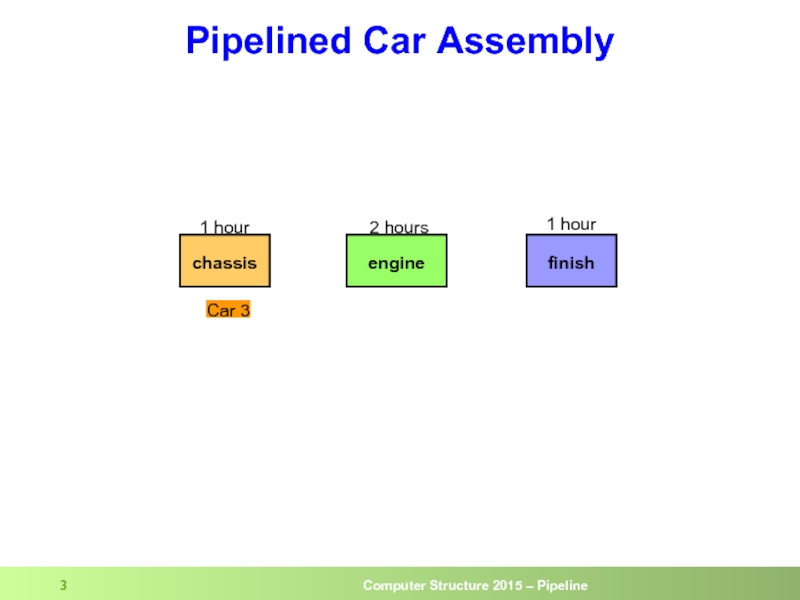
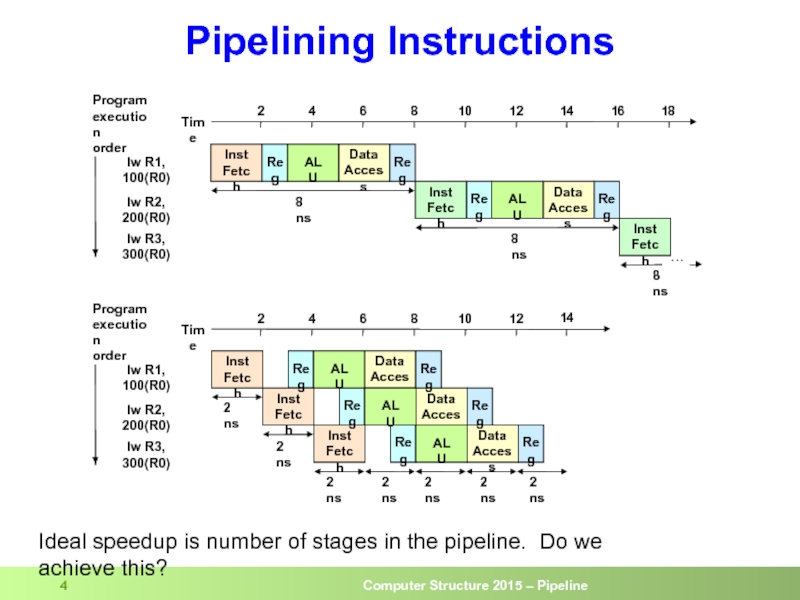
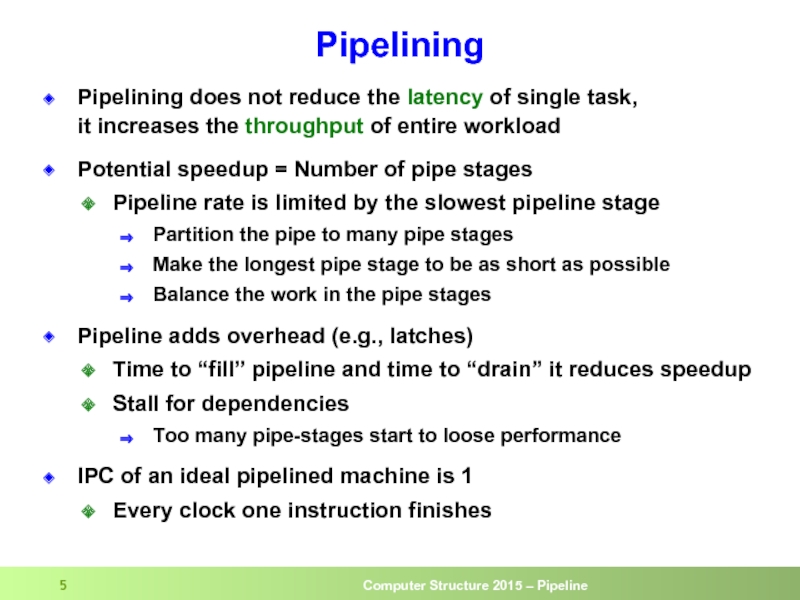
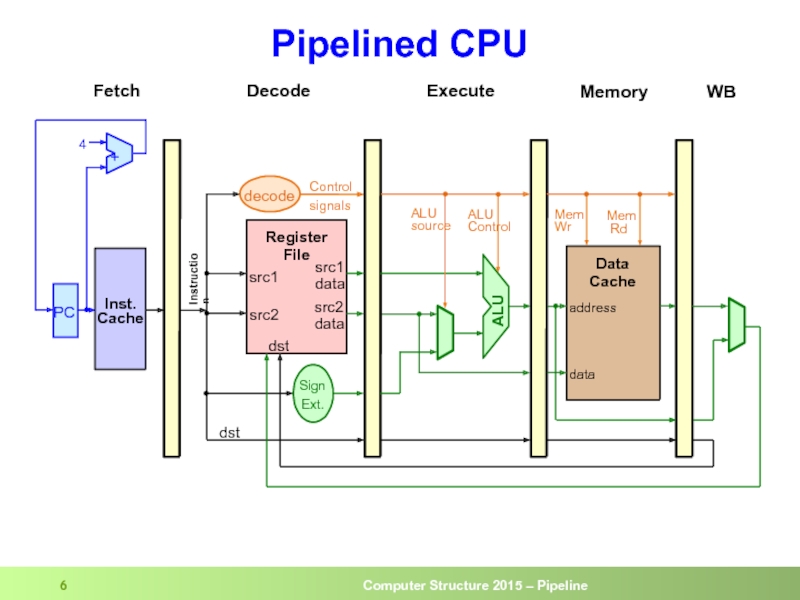
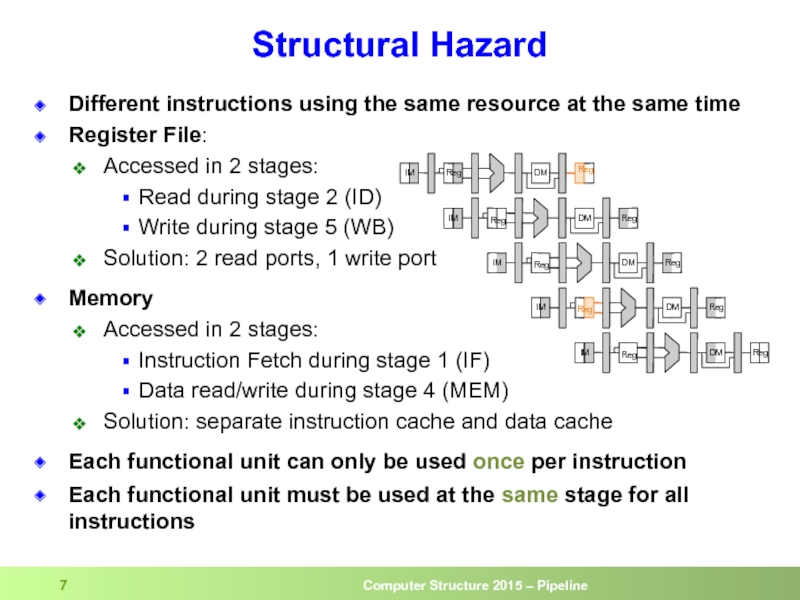
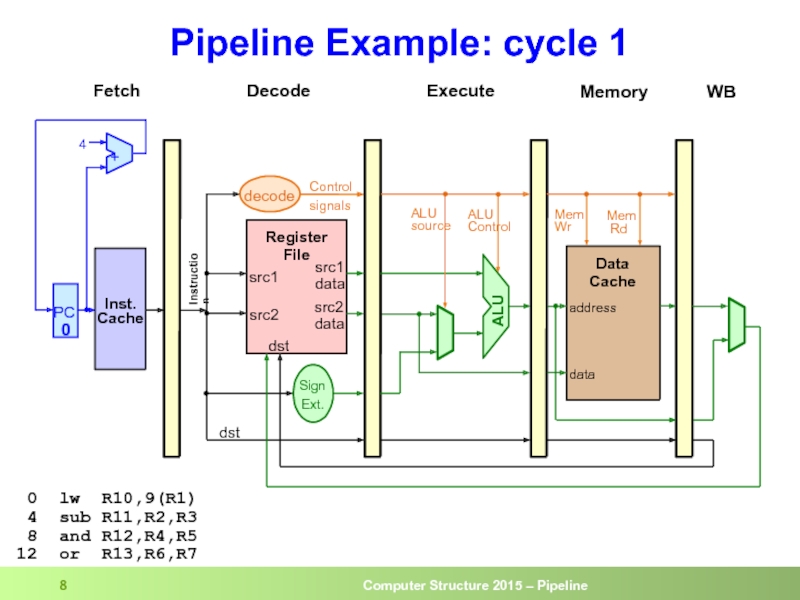

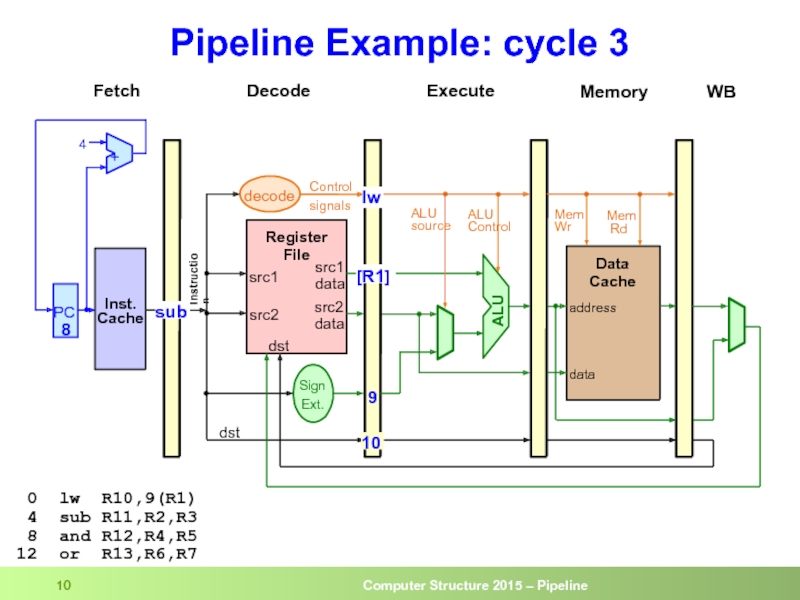
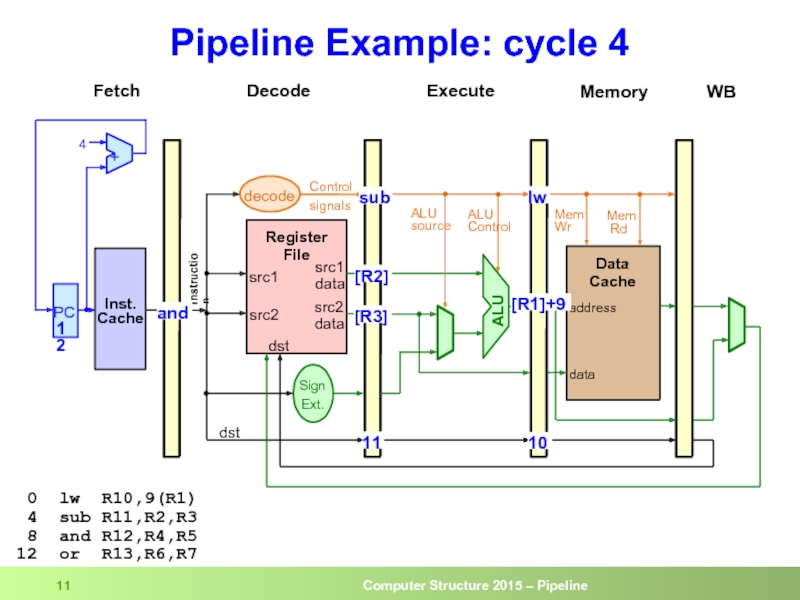
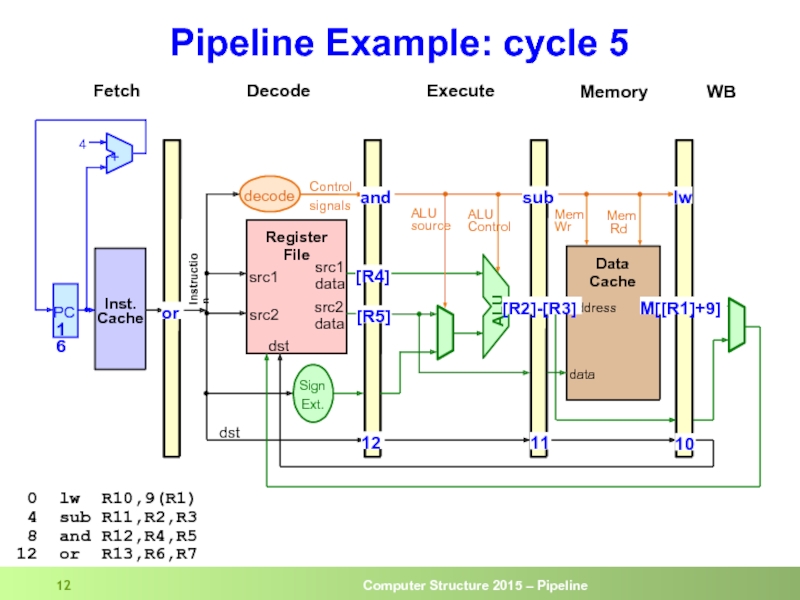
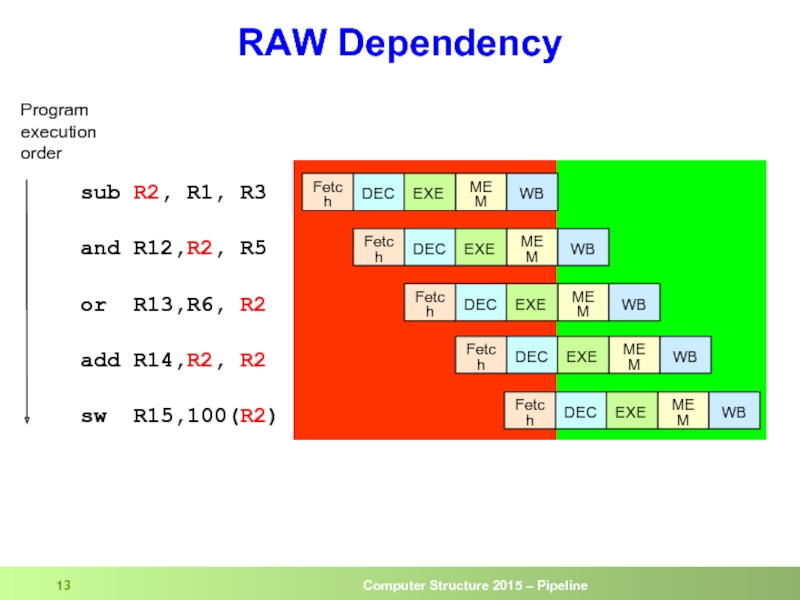
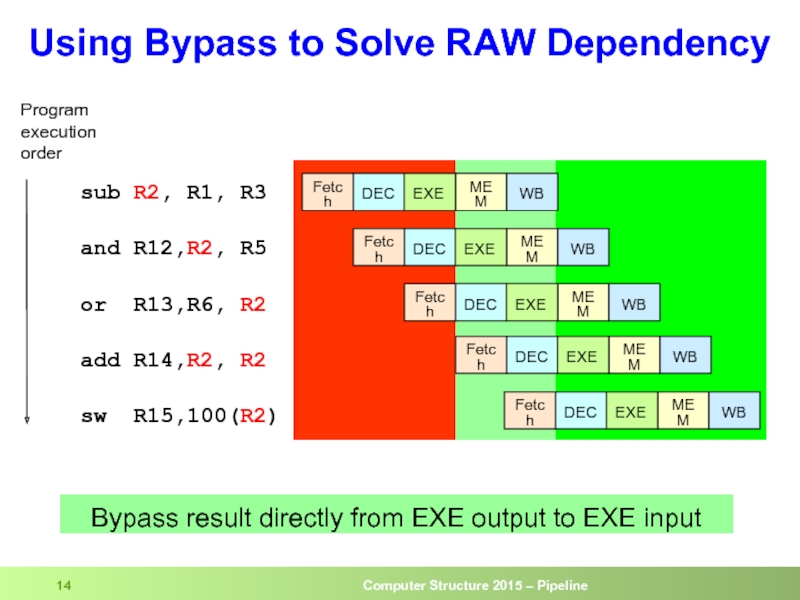
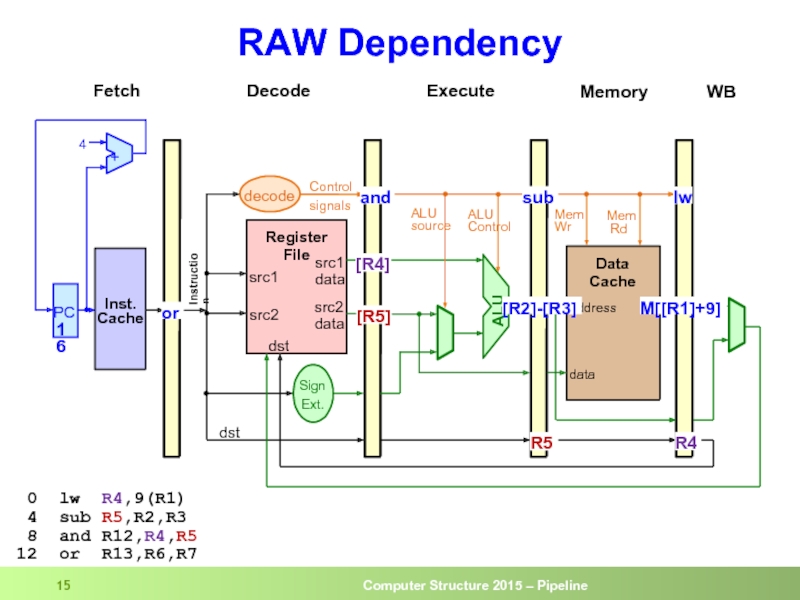
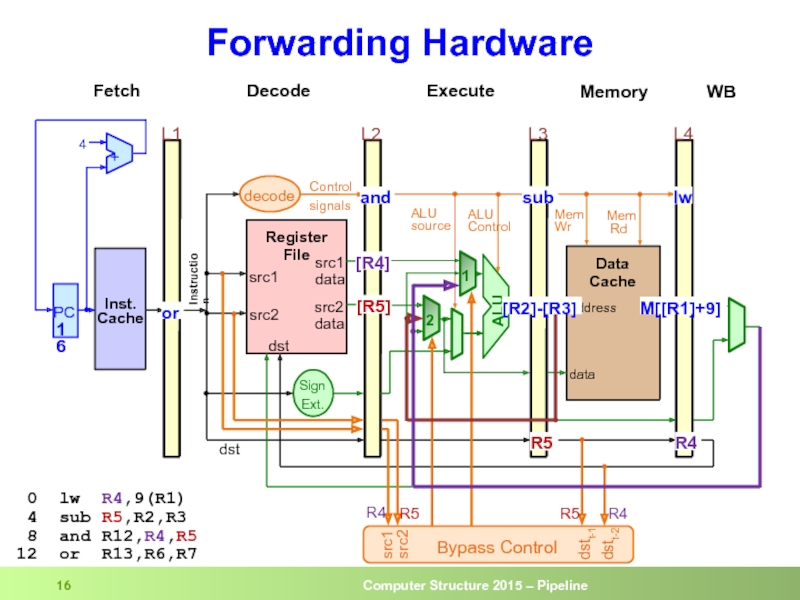
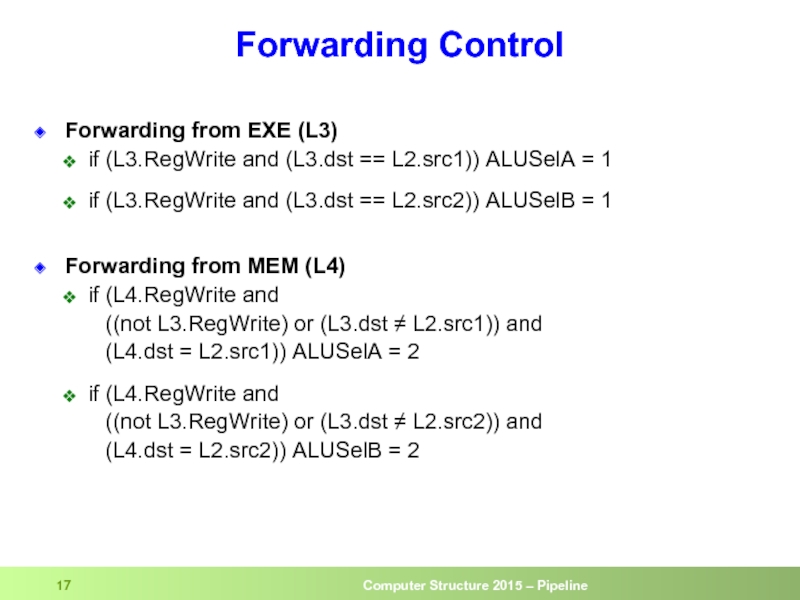
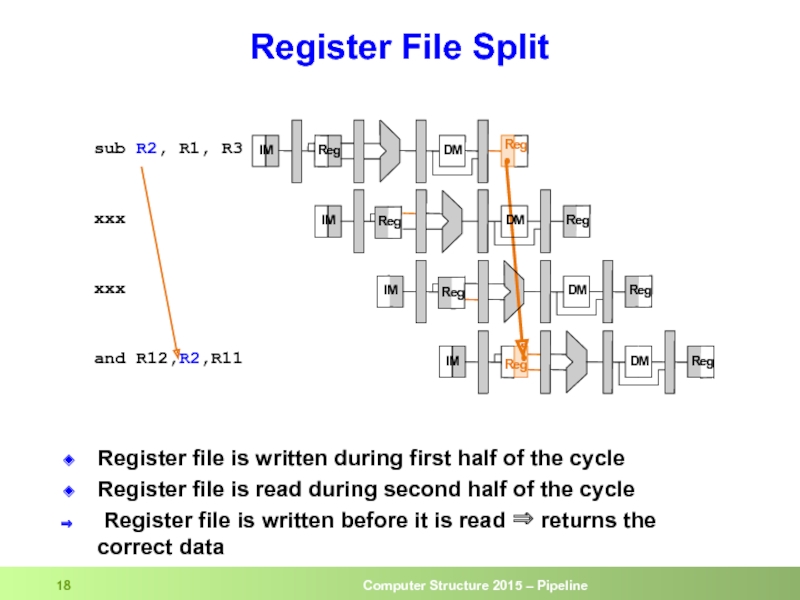
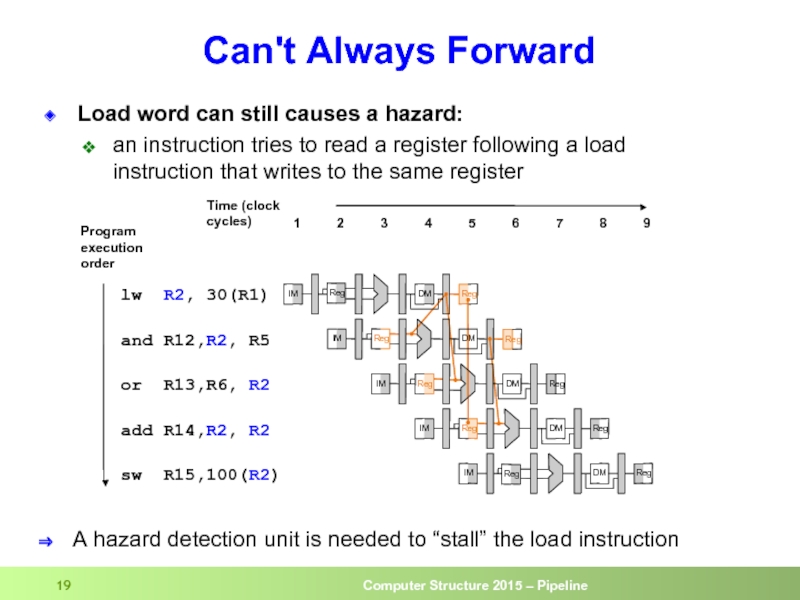
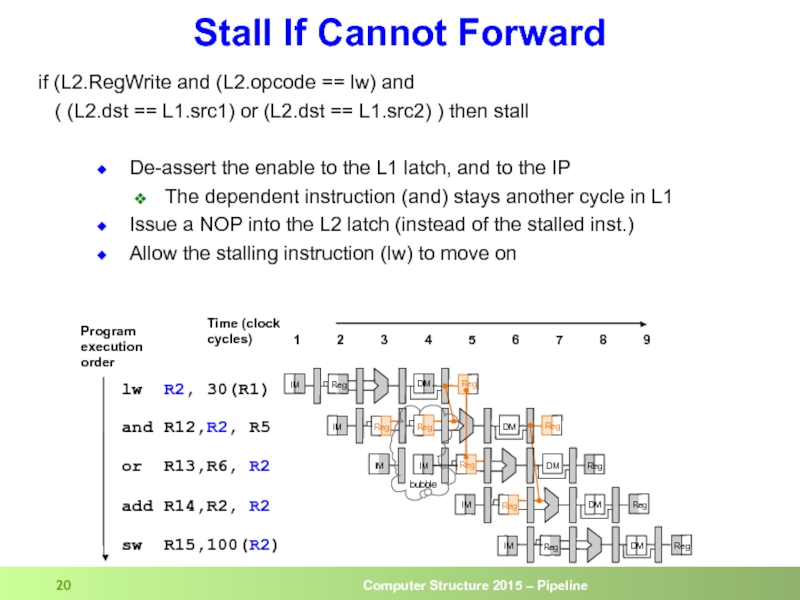
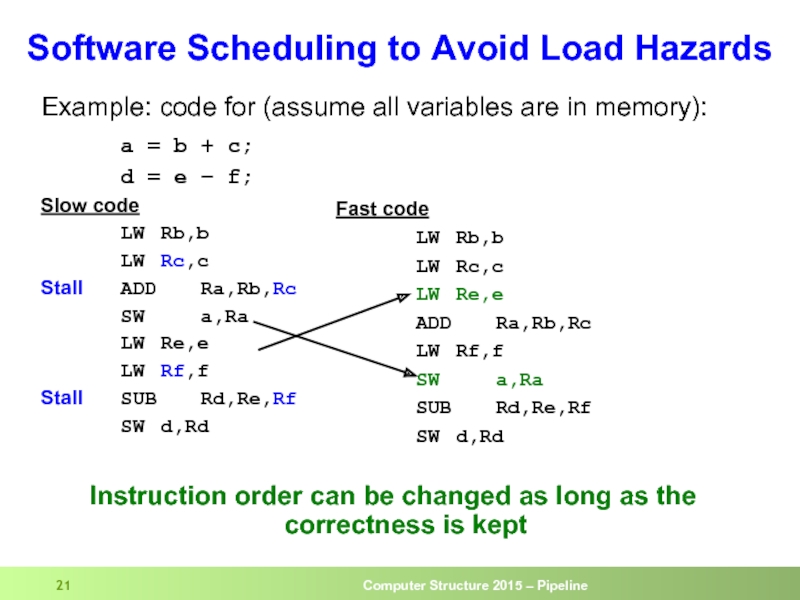
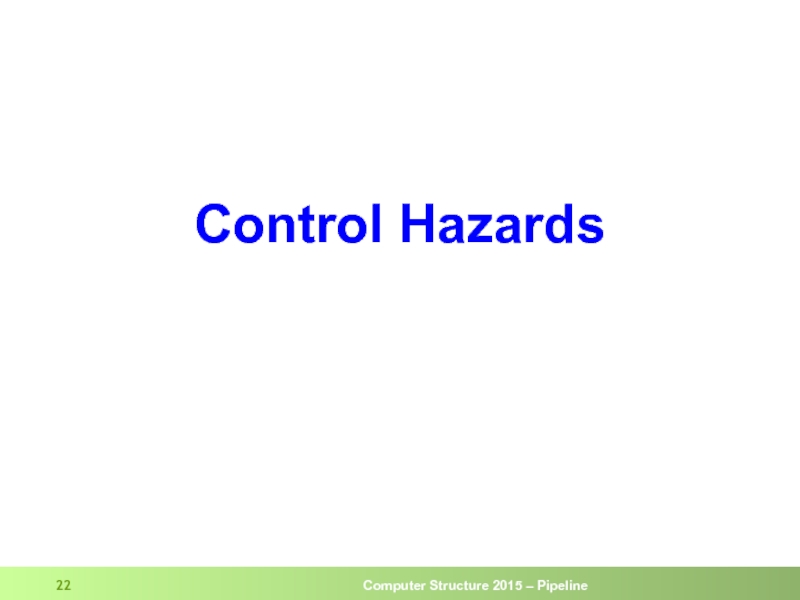
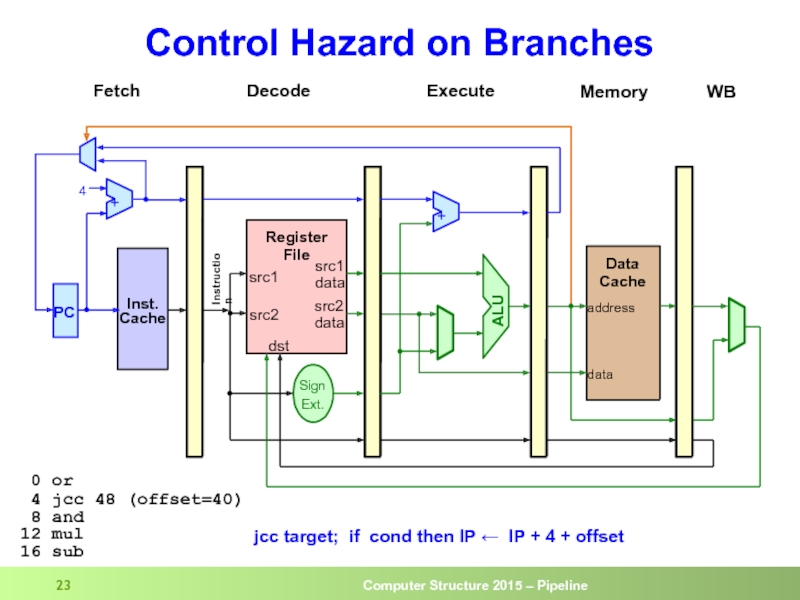
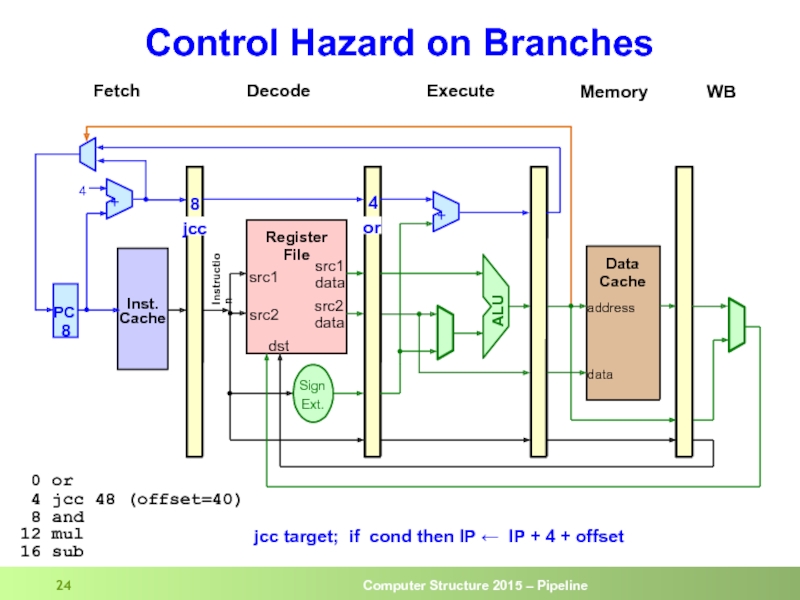


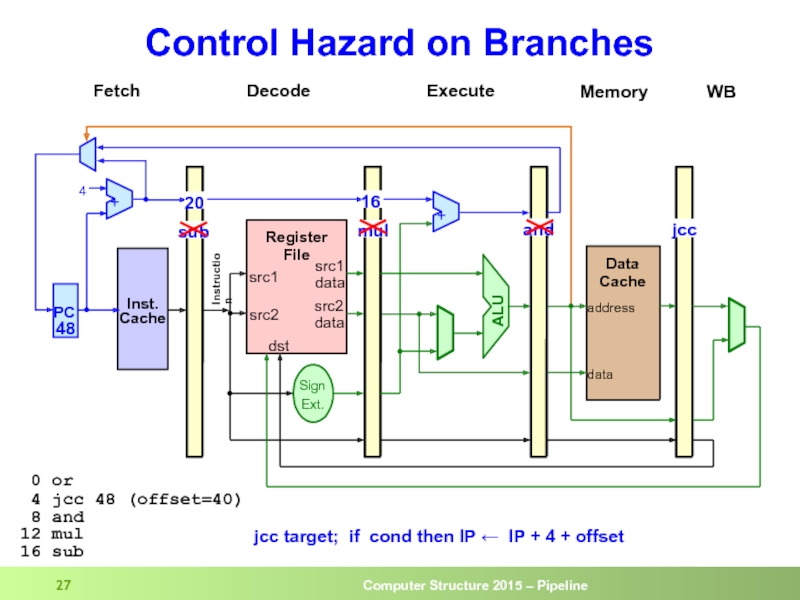
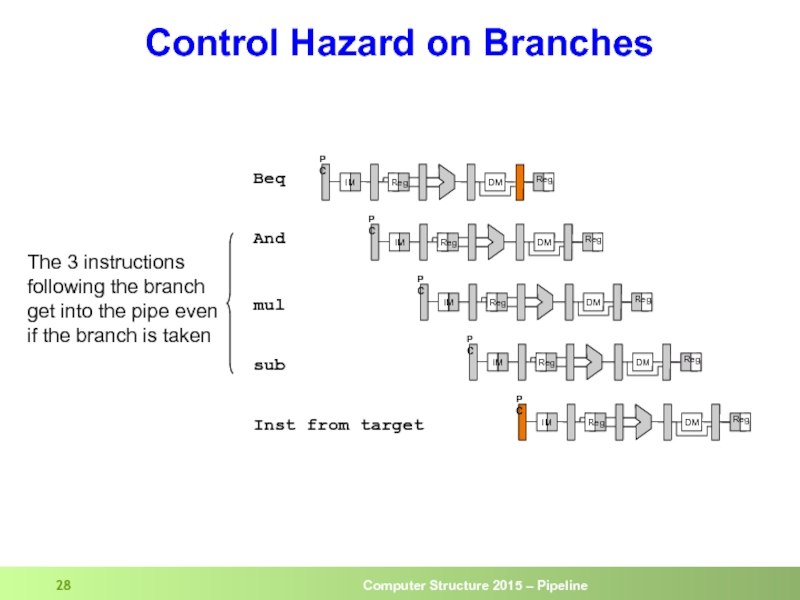
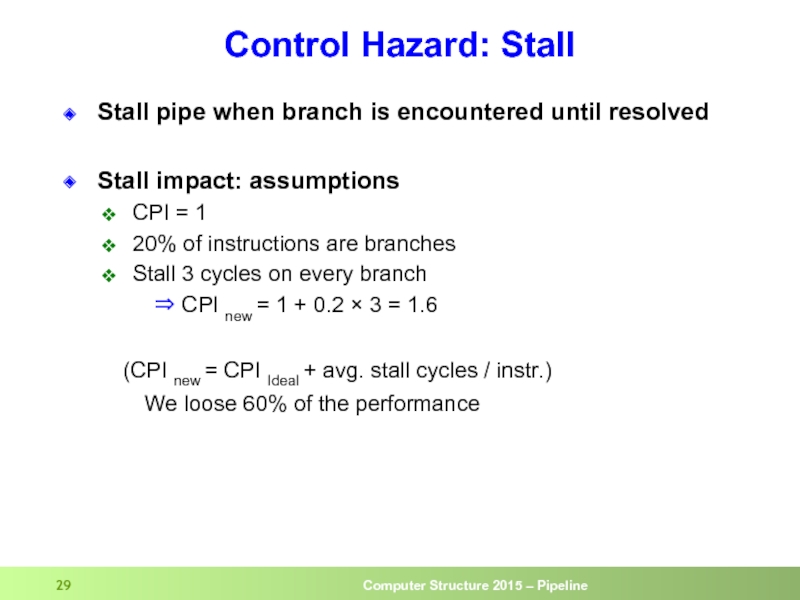
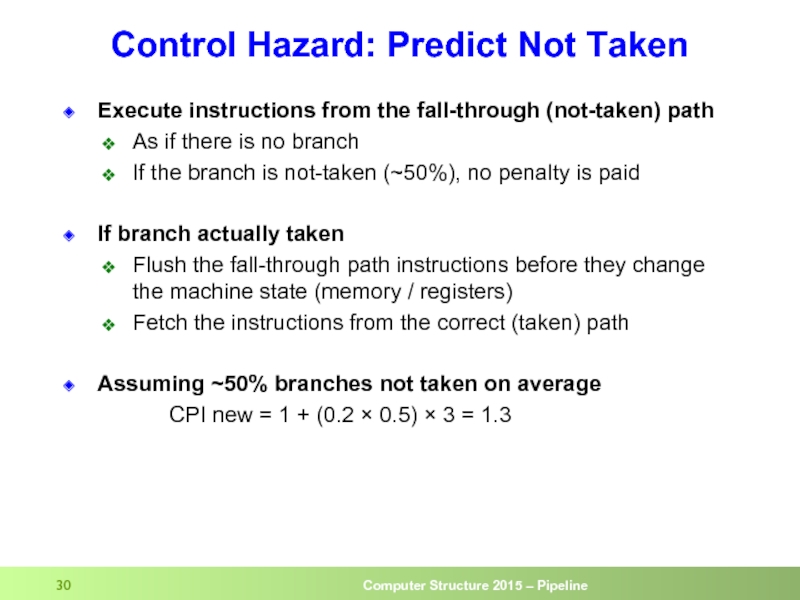
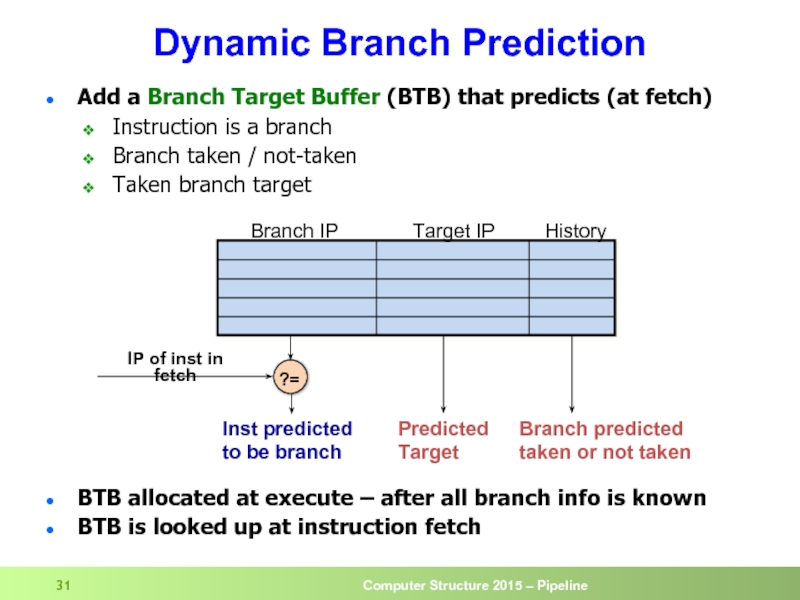
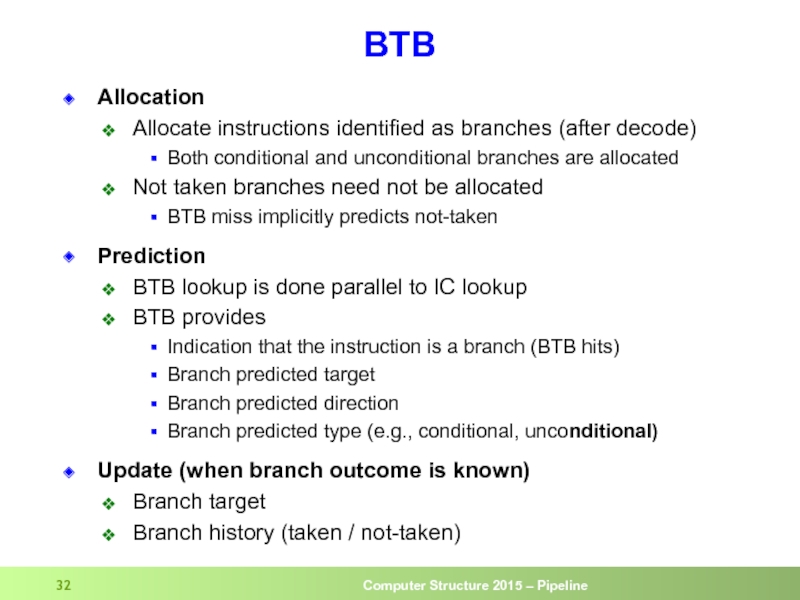
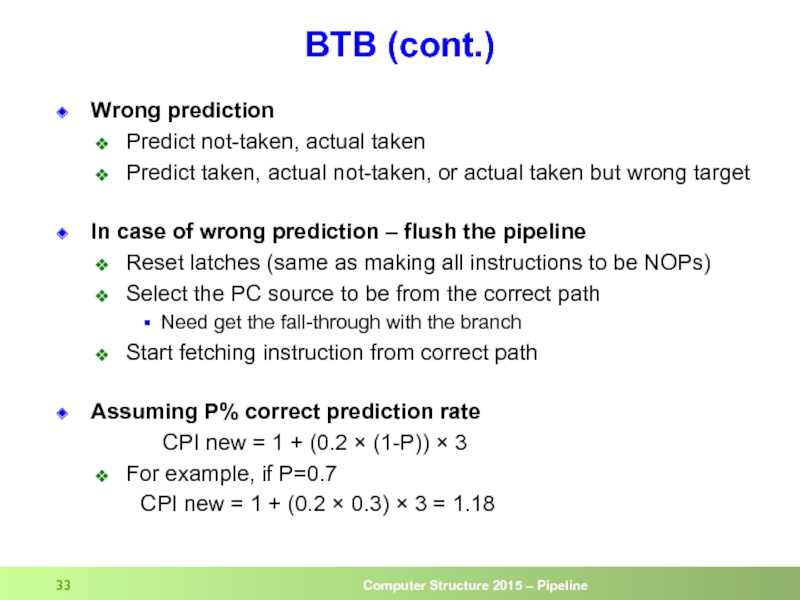
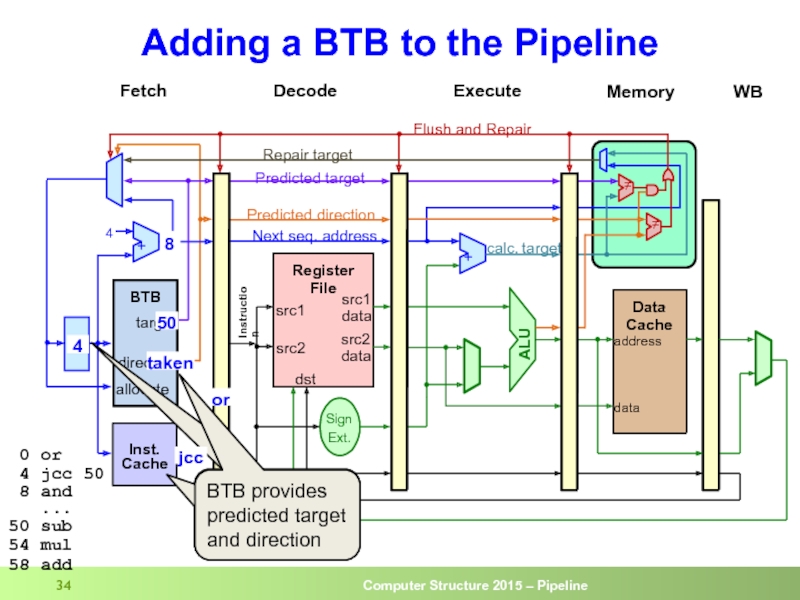
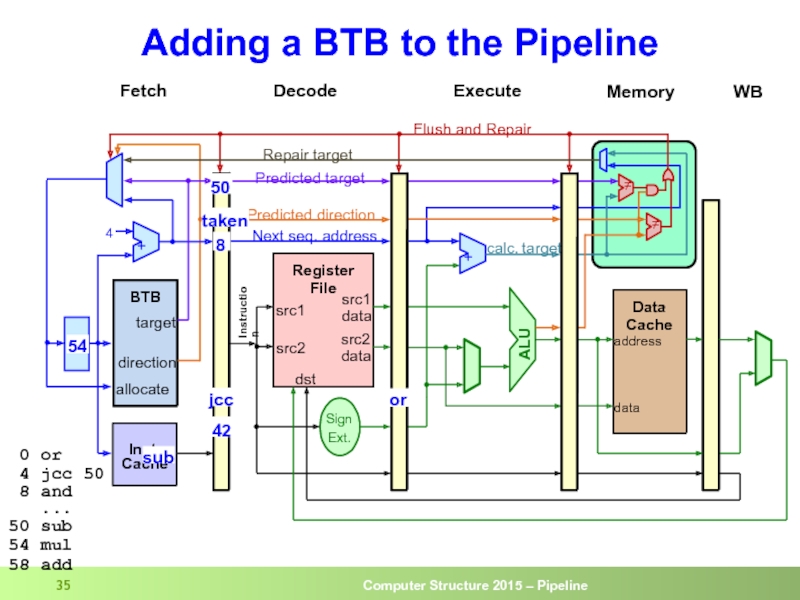
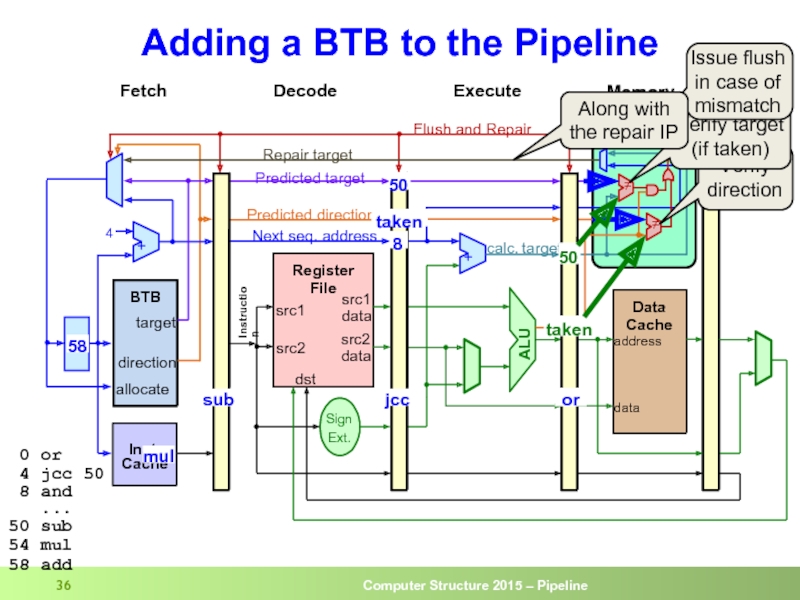
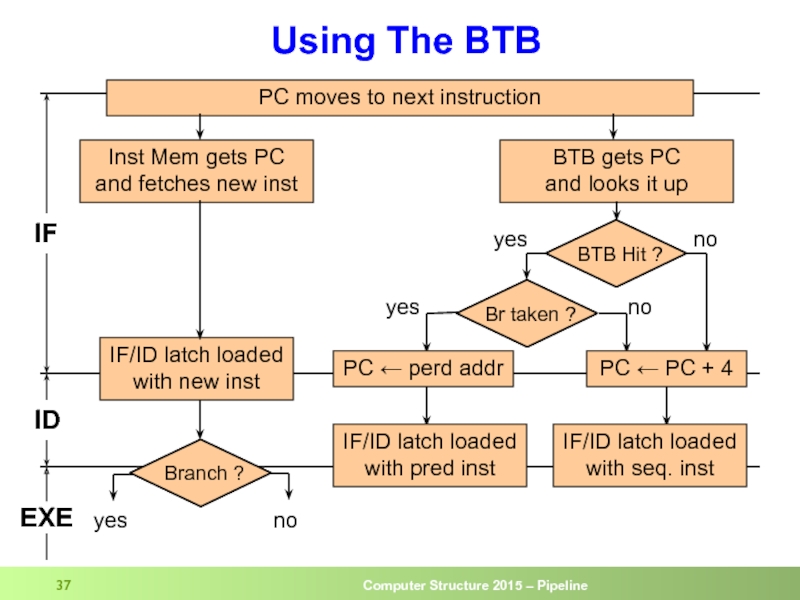
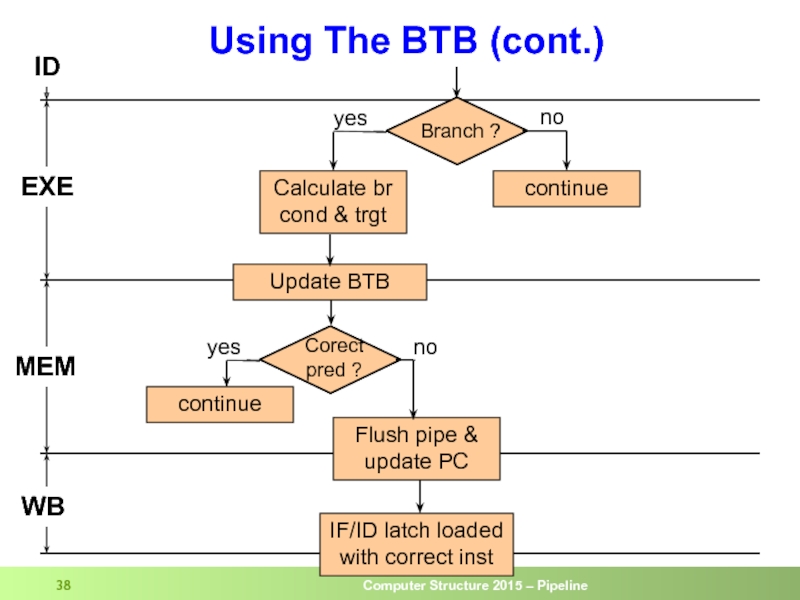

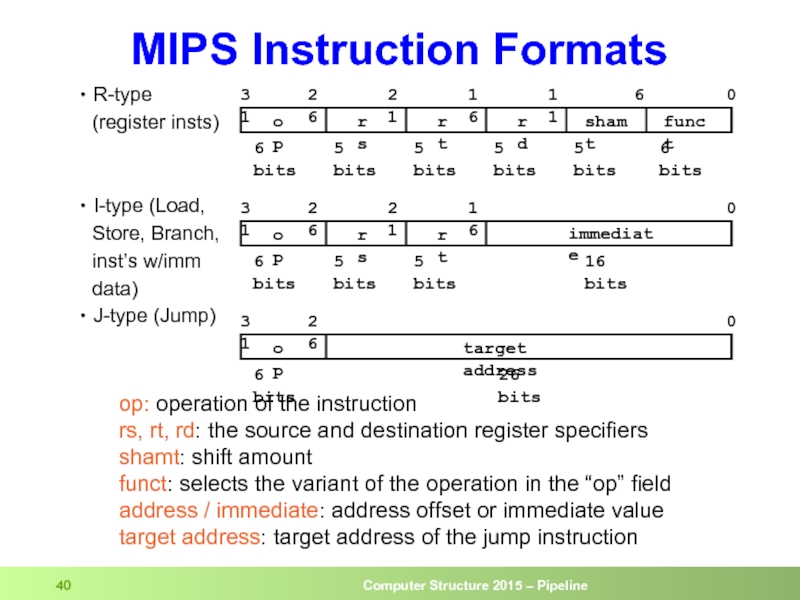
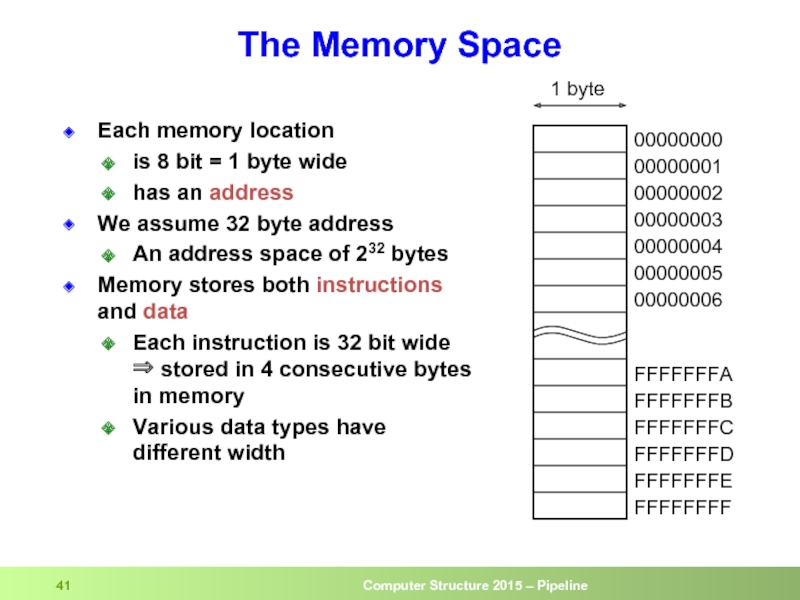
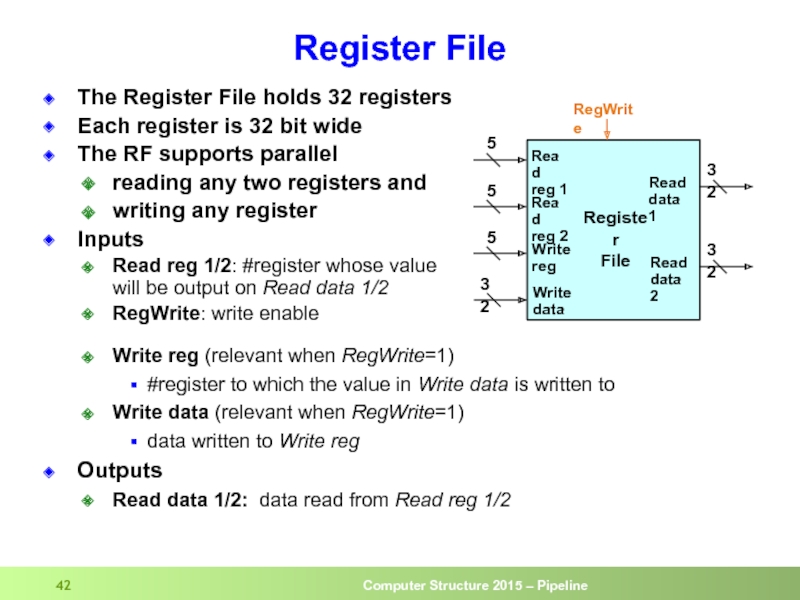
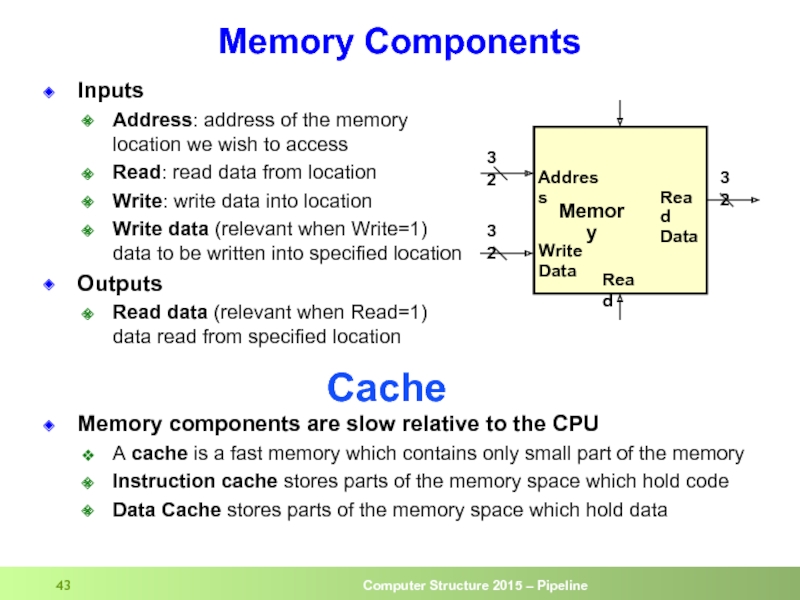
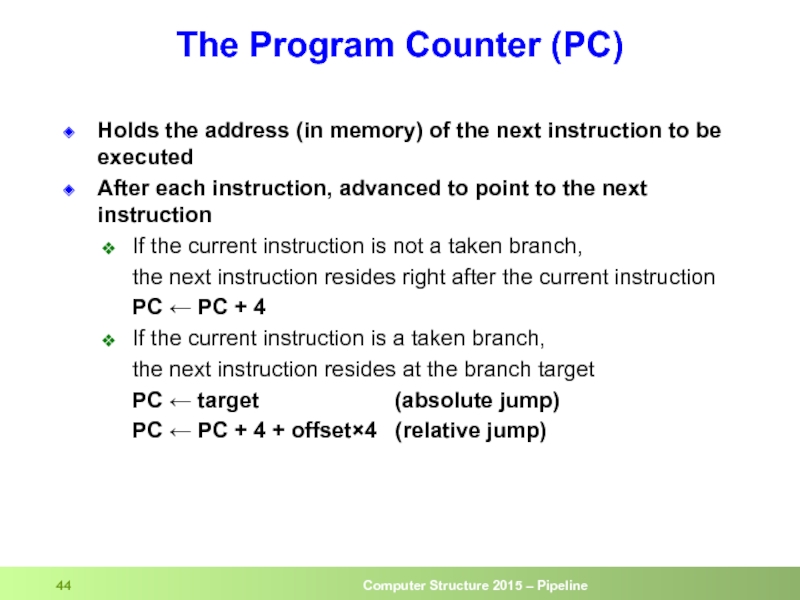
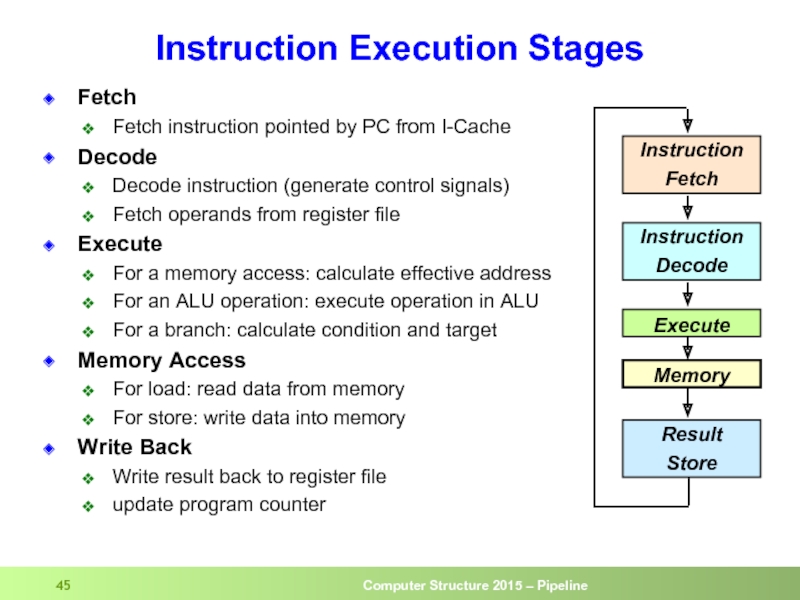
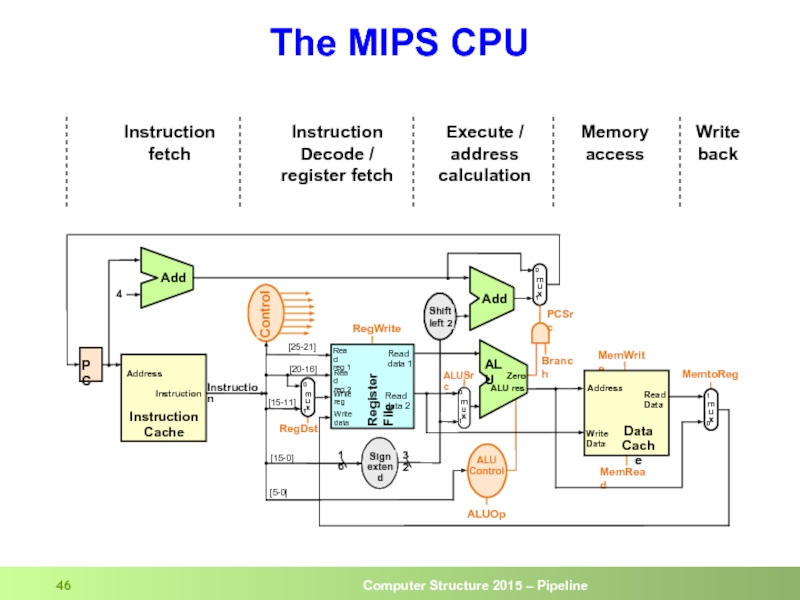
![Executing an Add InstructionR3R535R3 + R5+[PC]+42Add R2, R3, R5 ; R2 ← R3+R5ADD](/img/tmb/2/191591/a768f44502249f6f4f7acd2e0c41406c-800x.jpg)
![Executing a Load InstructionLW R1, (30)R2 ; R1 ← Mem[R2+30]](/img/tmb/2/191591/fea73aafed8a9d7e881c9d35e10da691-800x.jpg)
![Executing a Store InstructionSW R1, (30)R2 ; Mem[R2+30] ← R1](/img/tmb/2/191591/f5ac39ef09d4dfbd99eef726edca5041-800x.jpg)
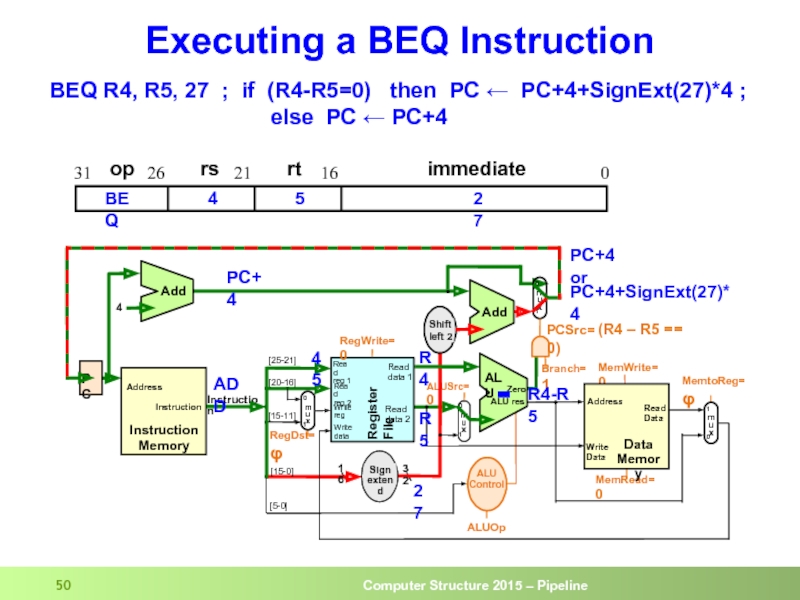
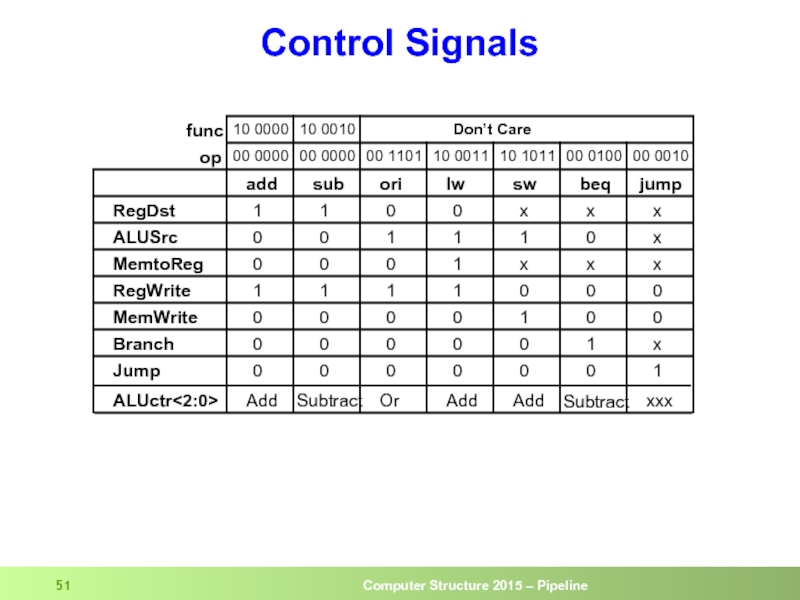
![Pipelined CPU: Load (cycle 1 – Fetch)lwoprsrtimmediate0162126312130LWLW R1, (30)R2 ; R1 ← Mem[R2+30]PC+4](/img/tmb/2/191591/ada4ef83fb15ece82c2533d4ef6a0a5e-800x.jpg)
![Pipelined CPU: Load (cycle 2 – Dec)oprsrtimmediate0162126312130LWLW R1, (30)R2 ; R1 ← Mem[R2+30]PC+4R230](/img/tmb/2/191591/b03f502517f989bab915b96320928575-800x.jpg)
![Pipelined CPU: Load (cycle 3 – Exe)oprsrtimmediate0162126312130LWLW R1, (30)R2 ; R1 ← Mem[R2+30]R2+30](/img/tmb/2/191591/32ef0e54cd90dd84dee68253b0f202fe-800x.jpg)
![Pipelined CPU: Load (cycle 4 – Mem)oprsrtimmediate0162126312130LWLW R1, (30)R2 ; R1 ← Mem[R2+30]D](/img/tmb/2/191591/0252d69b3e23fbc34b8a9704c9f47b14-800x.jpg)
![Pipelined CPU: Load (cycle 5 – WB)oprsrtimmediate0162126312130LWLW R1, (30)R2 ; R1 ← Mem[R2+30]D](/img/tmb/2/191591/0872d607a9a4cec8c345bd58df83479a-800x.jpg)

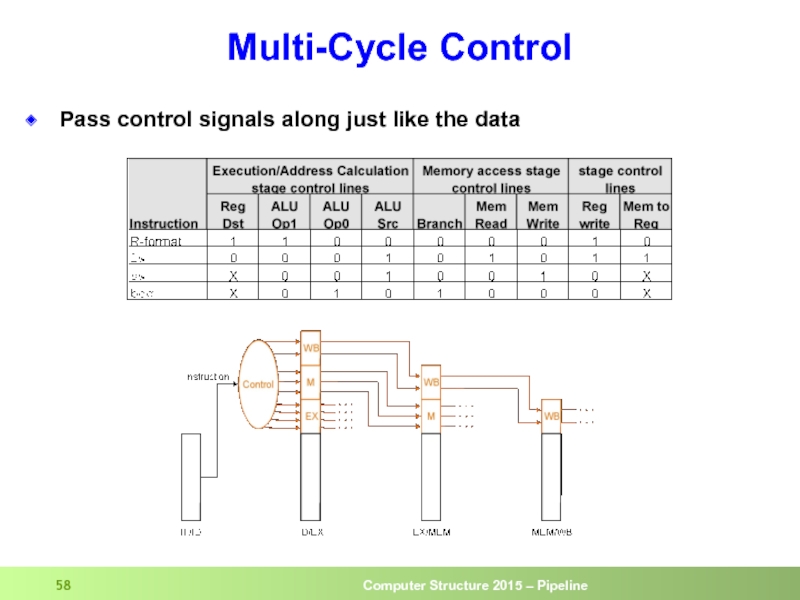
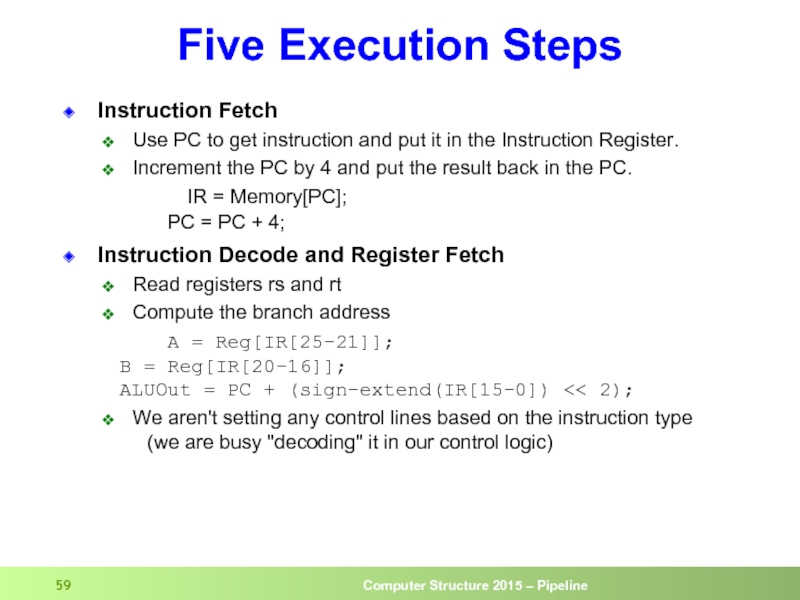
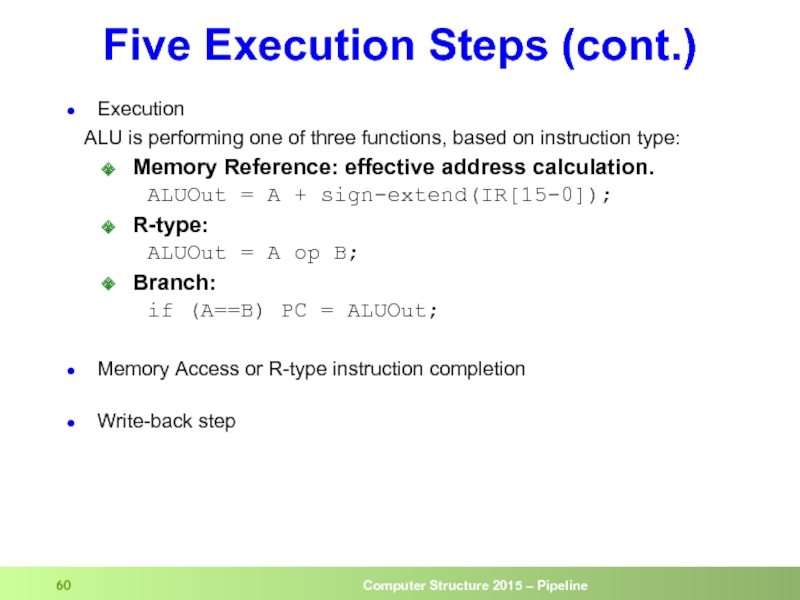
![The Store Instructionsw rt, rs, imm16mem[PC] Fetch the instruction from memoryAddr](/img/tmb/2/191591/573ace2c7468868528eb06062c6e2587-800x.jpg)

